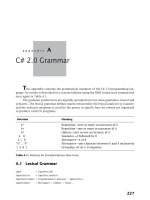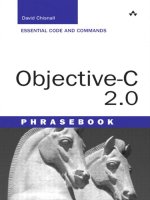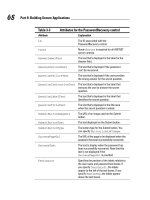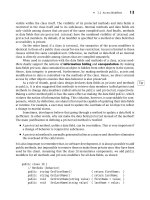Praise for C# 2.0: Practical Guide for Programmers 2005 phần 3 docx
Bạn đang xem bản rút gọn của tài liệu. Xem và tải ngay bản đầy đủ của tài liệu tại đây (451.34 KB, 26 trang )
36 Chapter 3: Class Members and Class Reuse
■
Console.WriteLine("|{0:P}|{1:N}|", 1.23, 1.23);
Console.WriteLine("|{0:X}|{1:X5}|{2,5:X}|{3,-5:X}|", 255, 255, 255, 255);
Console.WriteLine("|{0:#.00}|{1:0.00}|{2,5:0.00}|{3,-5:0.00}|",
.23, .23, .23, .23);
}
}
Output:
|$1.23|($1.23)|
|123|-0123|
|1.23|1.2300|
|1.230000E+000|1.23|
|123.00 %|1.23|
|FF|000FF| FF|FF |
|.23|0.23| 0.23|0.23 |
3.1.4 Declaring Destructors
The garbage collector in C# is an automatic memory management scheme that scans for
objects that are no longer referenced and are therefore eligible for destruction. Hence,
memory allocated to an object is recouped automatically by a garbage collector when
the object is no longer accessible (or reachable). Although the garbage collector may be
invoked directly using the GC.Collect method, this practice sidesteps the heuristics and
complex algorithms that are used to optimize system performance. Unless there are com-
pelling reasons to do otherwise, garbage collection is best left to the system rather than
the programmer. It is safer, easier, and more efficient.
However, an object may acquire resources that are unknown to the garbage collector,
such as peripheral devices and database connections. These resources are the respon-
sibility of the object itself and, therefore, the logic to release these resources must be
Type of Format Meaning
c or C Currency
d or D Decimal
e or E Scientific with “e" or “E" (6 digits)
f or F Fixed-point (12 digits)
g or G General (the most compact between E and F)
n or N Number
p or P Percent
x or X Hexadecimal
Table 3.1: Numeric format types.
■
3.2 Parameter Passing 37
implemented in a special method called a destructor. Although an object may be instan-
tiated in any number of ways, at most one destructor is declared per class. A destructor,
as shown here for the class Id, where Id is preceded by a tilde (˜), cannot be inherited,
overloaded, or explicitly invoked.
public class Id {
˜Id () { /* release of resources */ }
}
Instead, each destructor is invoked automatically but non-deterministically at the end
of a program or by the garbage collector itself. To ensure that a destructor is invoked
immediately once an object is no longer referenced, the IDisposable .NET design pattern
Tip
should be used as described in Section 9.1. Such a destructor is also called a finalizer in
the .NET context.
3.2 Parameter Passing
As described earlier in the chapter, each method in C# has an optional sequence of formal
parameters. Each formal parameter, in turn, represents a special kind of local variable
that specifies the type of argument that must be passed to the given method. Like other
local variables, formal parameters are allocated on the stack when a method is invoked
and are deallocated when the method completes its execution. Therefore, the lifetime of a
parameter and the lifetime of its method are synonymous. Finally, arguments are passed
to formal parameters in one of two ways: by value or by reference. These ways are
explored in greater detail in the following two sections.
3.2.1 Passing Arguments by Value
When an argument is passed by value, the formal parameter is initialized to a copy of the
actual argument. Therefore, the actual argument itself cannot be modified by the invoked
method. In the following example, an integer variable p is passed by value to a formal
parameter of the same name. Although the formal parameter may change its local copy
of p, the value of p in the main program retains its original value after the invocation of
ParambyValue.
using System;
class ParambyValue {
static void Fct(int p) {
Console.WriteLine("In Fct: p = {0}", ++p);
}
static void Main() {
intp=1;
Console.WriteLine("Before: p = {0}", p);
Fct(p);
38 Chapter 3: Class Members and Class Reuse
■
Console.WriteLine("After: p = {0}", p);
}
}
Output:
Before:p=1
InFct:p=2
After: p = 1
3.2.2 Passing Arguments by Reference
When an argument is passed by reference, any changes to the formal parameter are
reflected by the actual argument. In C#, however, there are two types of reference param-
eters: ref and out. If the formal parameter is preceded by the modifier ref then the actual
argument must be explicitly initialized before invocation and be preceded by the modifier
ref as well. In the following example, the variables a and b in the Main method are explic-
itly initialized to 1 and 2, respectively, before the invocation of Swap. Explicit initialization
precludes implicit initialization by default and therefore, without the assignment of 1 and
2toa and b, respectively, the default values of 0 would raise a compilation error.
using System;
class ParamByRef {
static void Swap(ref int a, ref int b) {
intt=a;
a=b;
b=t;
}
static void Main() {
inta=1;
intb=2;
Console.WriteLine("Before: a = {0}, b = {1}", a, b);
Swap(ref a, ref b);
Console.WriteLine("After: a = {0}, b = {1}", a, b);
}
}
Output:
Before:a=1,b=2
After: a = 2,b=1
If the formal parameter and actual argument are preceded by the modifier out then the
actual argument does not need to be initialized before invocation. In other words, the
return value is independent of the initial value (if any) of the actual argument. The modifier
■
3.2 Parameter Passing 39
out is used to indicate that the formal parameter will be assigned a value to be returned
to its corresponding argument. Since the use of an unassigned variable is not allowed in
C#, this modifier can be used to initialize (or reset) local variables to default values as
shown:
using System;
class ParamByRefWithOut {
static void SetRange(out int min, out int max) { min = 0; max = 255; }
static void Main() {
int min, max;
SetRange(out min, out max);
Console.WriteLine("Begin: min = {0}, max = {1}", min, max);
min++; max ;
Console.WriteLine("Change: min = {0}, max = {1}", min, max);
SetRange(out min, out max);
Console.WriteLine("End: min = {0}, max = {1}", min, max);
}
}
Output:
Begin: min = 0, max = 255
Change: min = 1, max = 254
End: min = 0, max = 255
In the preceding examples, all arguments were of the integer type int. Reference types,
however, can also be passed by value or by reference. Because a reference-type argument
points to an object stored on the heap and does not represent the object itself, modifi-
cations to the object can be made using both parameter-passing mechanisms. Passing a
reference-type argument by value simply copies the memory address of the object to the
formal parameter. Passing a reference-type argument by reference implies that the pointer
itself can be modified and reflected by the actual argument. By changing the reference-type
parameter, the pointer is modified to reference an entirely different object of the same
class. If that is not the intent, then passing a reference-type argument by value ensures
that only the object itself and not the reference to the object can be modified. The following
example illustrates this behavior.
using System;
class Counter {
public void Inc() { count++; }
public int GetCount() { return count; }
private int count;
40 Chapter 3: Class Members and Class Reuse
■
}
class ParamByValByRefWithObjects {
static void SayBye(ref string msg) { msg = "Bye!"; }
static void SayGoodBye(string msg) { msg = "Goodbye!"; }
static void IncR(ref Counter c) {
c = new Counter();
c.Inc();
Console.Write("cR = {0} ", c.GetCount());
}
static void IncV(Counter c) {
c = new Counter();
c.Inc();
Console.Write("cV = {0} ", c.GetCount());
}
static void Main() {
string msg = "Hello!";
Console.Write("{0} ", msg);
// (1)
SayGoodBye(msg);
Console.Write("{0} ", msg);
// (2)
SayBye(ref msg);
Console.WriteLine("{0} ", msg);
// (3)
Counter cm = new Counter();
Console.WriteLine("cm = {0}", cm.GetCount());
// (4)
IncV(cm);
Console.WriteLine("cm = {0}", cm.GetCount());
// (5)
IncR(ref cm);
Console.WriteLine("cm = {0}", cm.GetCount());
} // (6)
}
Output:
Hello! Hello! Bye!
cm=0
cV=1cm=0
cR=1cm=1
In Figure 3.1, steps 1 to 6 correspond to the comments in the listing above. At (1), the
reference variable msg points to the literal string object "Hello!". Between (1) and (2),
■
3.2 Parameter Passing 41
(1) main’s msg “Hello!”
“Goodbye!”
“Bye!”
“Hello!”
“Hello!”
count = 0
count = 0
count = 1
count = 1
count = 0
X
X
X
X
X
(4) cm
(5) cm
IncV’s c
(6) cm
IncR’s c
(2) SayGoodBye’s msg
main’s msg
(3) SayBye’s msg
main’s msg
Figure 3.1: Parameter passing by value and by reference with objects.
the formal parameter msg of SayGoodBye is assigned a copy of the actual argument msg in
Main. The parameter msg is then assigned a reference to the literal string "Goodbye!". Once
the method completes its execution, the reference to "Goodbye!" is lost as indicated by
the X, and there is no impact on msg in Main. Between (2) and (3), the actual argument
msg of Main is passed by reference to msg of SayBye. The parameter msg is then assigned
a reference to the literal "Bye!", which is also reflected by msg in Main. The literal string
object "Hello!", then, is no longer reachable and is marked for garbage collection.
At (4), the object cm is created and initialized to zero by default. Between (4) and
(5), the argument cm of Main is passed by value to c of IncV. Hence, c is a copy of the
reference cm. The parameter c is then assigned a reference to a new object of Counter.
The count field of c is incremented by 1 and displayed. However, once the IncV method
completes its execution, the reference to c is lost, and there is no impact on cm in Main.
On the other hand, when cm is passed by reference, the creation of a new Counter in the
IncR method is assigned directly to cm in Main. Therefore, the reference cm to the original
object is lost and replaced by a reference to the object created within IncR. Output at (6)
confirms that c and cm refer to the same object.
3.2.3 Passing a Variable Number of Arguments
In C/C++, trying to pass a variable number of arguments via the varargs structure com-
promises the type-checking capabilities of the compiler. To enforce type safety, the C#
language is equipped with a third parameter modifier called params. The modifier params
42 Chapter 3: Class Members and Class Reuse
■
is followed by an open array of a specific type. Because the array is expecting values
of a given type, type checking is enforced at compile time. In the following example, the
method Fct is expecting to receive zero or more integer arguments, each of which is stored
consecutively in the open array called args. Because the number of arguments is variable,
the params modifier can only be applied to the last parameter.
using System;
class ParamByRefWithParms {
static void Fct(params int[] args) {
Console.Write ("{0} argument(s): ", args.Length);
for(intn=0;n<args.Length; n++)
Console.Write("{0} ", args[n]);
Console.WriteLine();
}
static void Main() {
Console.WriteLine(" args[n]:0123");
Fct();
Fct(1);
Fct(1, 2);
Fct(1, 2, 3);
Fct(new int[] {1, 2, 3, 4});
}
}
Output:
args[n]:0123
0 argument(s):
1 argument(s): 1
2 argument(s): 1 2
3 argument(s):123
4 argument(s):1234
The last invocation of Fct in the main program passes an anonymous array.
3.2.4 Using the this Reference
The keyword this is an argument that is implicitly passed to each instance method and
serves as a self-reference to the current object. Using the this reference, one can differ-
entiate between a method argument and a data field that share the same name, as shown:
public class Counter {
public Counter(int count) { this.count = count; }
private int count;
}
■
3.2 Parameter Passing 43
Overuse of the this reference, however, may impair readability. Alternatively, a common
style convention used in C++, Java, and C# adds an underscore as a prefix or suffix to the
Tip
local data member:
public class Counter {
public Counter(int count) { _count = count; }
private int _count;
}
A current method may also be accessed via the this reference. For instance, suppose
that the Counter class included an additional method called Init to set or reset count to
a specific value. In the following example, the method Init is called from the Counter
constructor:
public class Counter {
public Counter(int count) {
this.Init(count); // Same as Init(count)
}
public void Init(int count) {
this.count = count;
}
private int count;
}
Because the this prefix is implicitly understood, it is generally not included in the
invocation of a current method.
Finally, the this reference can be used as part of a callback. A callback is a way
for one object, A for example, to retain a reference to another object B so that A may “call
back” a method in B at any time. The purpose of a callback is to anonymously invoke a
method by referencing only the object, in our case A, that retains the other reference to B.
Hence, the reference to B is hidden within A. In the next example, an amount of money is cal-
culated both with and without a discount. An instance of the Amount class is first created on
line 26 and its reference is passed to two static methods on lines 31 and 35, respectively.
The first method called TotalWithNoDiscount gives no discount and simply retrieves the
value of a using its Get method. The second method called TotalWithDiscount calculates
a 20% discount. This method first creates an instance of Discount via the CreateDiscount
method of Amount.InCreateDiscount on line 6, the constructor of Discount is invoked and
the current reference of Amount is passed and assigned to amount within the newly created
instance of Discount on line 11. Once the instance of Discount is created and retains the
reference to Amount, its Apply method is invoked on line 20. Within Apply, the amount
44 Chapter 3: Class Members and Class Reuse
■
reference is used to call back the Get method of Amount, retrieve its value, and return the
discounted value (line 13).
1 using System;
2
3 public class Amount {
4 public Amount(double buy) { this.buy = buy; }
5 public double Get() { return buy; }
6 public Discount CreateDiscount() { return new Discount(this); }
7 private double buy;
8}
9
10 public class Discount {
11 public Discount(Amount amount) { this.amount = amount; }
12 public double Apply() {
13 return amount.Get() * 0.80; // Callback amount to apply
14 } // 20% discount.
15 private Amount amount;
16 }
17
18 public class TestCallback {
19 public static double TotalWithDiscount(Amount a) {
20 return a.CreateDiscount().Apply(); // Create a discount
21 } // then apply.
22 public static double TotalWithNoDiscount(Amount a) {
23 return a.Get();
24 }
25 public static void Main() {
26 Amount a = new Amount(60.00);
27
28 // Use amount without applying a discount (no call back).
29
30 Console.WriteLine("Please pay {0:C} (no discount)",
31 TotalWithNoDiscount(a));
32 // Use amount and apply a discount (call back).
33
34 Console.WriteLine("Please pay {0:C} (20% discount)",
35 TotalWithDiscount(a));
36 }
37 }
Output:
Please pay $60.00 (no discount)
Please pay $48.00 (20% discount)
■
3.3 Class Reuse 45
3.2.5 Overloading Methods
Overloading a method means to declare several methods of the same name. But in order
to distinguish among methods, each one must have a distinct parameter list, bearing in
mind that the return type and the parameter modifier params are not part of a method
signature.
1 class MethodOverloading {
2 void Fct(int i) { }
3 int Fct(int i) { } // error: same signature as line 2
4 void Fct(char c) { }
5 void Fct(int[] args) { }
6 void Fct(params int[] args) { } // error: same signature as line 5
7}
3.3 Class Reuse
One of the principal benefits of object-oriented technology is the ability to reuse and
extend classes. The growing libraries of reusable code in Java and C# reflect the impor-
tance and economy of building code from existing components. Reusing code that has
weathered extensive testing gives rise to software products that are more robust, main-
tainable, and reliable. In this section, we examine two fundamental ways, inheritance
and aggregation, that create classes from ones that already exist. To draw a comparison
between the two ways, a simple class called Counter is first defined.
public class Counter {
public Counter() { SetCount(0); }
public Counter(int count) { SetCount(count); }
public int GetCount() { return count; }
public void SetCount(int count) { this.count = count; }
private int count;
}
The class Counter has two constructors, a parameterless constructor that initializes count
to 0 and an overloaded constructor that initializes count to its single parameter. Both
constructors invoke SetCount. The class also includes the method GetCount that returns
the current value of count.
We will now extend the Counter class, first via aggregation and second via inheritance,
to create another class called BoundedCounter. Objects of the BoundedCounter class behave
essentially the same as those objects of Counter, but with one key difference: The private
data member count is only valid between two user-defined values, min and max. Although
the class BoundedCounter places the onus on the client to check that count falls between
min and max, provisions are made to return these bounds for testing.
46 Chapter 3: Class Members and Class Reuse
■
3.3.1 Using Aggregation
Aggregation, otherwise known as a “has-a” or “part-of” relationship, gathers one or more
objects from various classes and places them inside another class. Aggregation, therefore,
reuses classes by assembling objects of existing classes to define, at least in part, the data
members and methods of a new class. In order to define the class BoundedCounter, a single
object of the Counter class is placed inside BoundedCounter along with two additional data
members, min and max. Also included are methods to return the minimum and maximum
values, GetMax and GetMin, as well as a method InitRange to set the bounds. By default,
the count for an object of BoundedCounter is initialized to min upon creation.
public class BoundedCounter {
public BoundedCounter (int min, int max) {
this.c = new Counter(min); // Creates a private Counter c
InitRange(min, max);
}
private void InitRange(int min, int max) {
this.min = min;
this.max = max;
}
public int GetCount() { return c.GetCount(); }// Reuses object c
public void SetCount(int count) { c.SetCount(count); } // Reuses object c
public int GetMin() { return min; }
public int GetMax() { return max; }
private Counter c; // Reuses object Counter c by aggregation
private int min;
private int max;
}
Although aggregation does work to define BoundedCounter, it is not a particularly elegant
solution. The methods GetCount and SetCount of BoundedCounter are reimplemented using
the existing methods of Counter. In this case, where behavior is common, inheritance pro-
vides a better mechanism than aggregation for class reuse. In Section 3.3.3, the opposite
is demonstrated.
3.3.2 Using Inheritance
Inheritance, otherwise known as an “is-a” or “kind-of” relationship, allows a class of objects
to reuse, redefine, and possibly extend the functionality of an existing class. Therefore,
one class, called the derived or subclass, “inherits” all data members and methods of its
base or superclass with the exception of instance constructors. Also, it should be noted
with respect to the encapsulation principle that private data members of the base class
are not directly accessible from their derived classes except through protected or public
methods.
■
3.3 Class Reuse 47
Rather than being inherited, instance constructors of the superclass are called either
implicitly or explicitly upon creation of an object from the derived class. This exception is
best motivated by noting that an object from an inherited class is a “specialized” instance
of the base class. Without first creating an instance of the base class, it is simply not
possible to create an instance of the derived class. If the base class has no constructor
and a default constructor is generated automatically by the compiler, then the compiler
can also generate a default constructor for the derived class. Otherwise, the derived class
must have at least one constructor.
Like Java, C# only supports single inheritance; that is, a class can only inherit from
one other class at a time. Although multiple inheritance is more flexible, reuse is also more
difficult. However, as will be seen in Chapter 7, C# does offer a sound software engineering
alternative by allowing the implementation of multiple interfaces rather than classes.
Syntactically, one class inherits from another by placing a colon (:) between the
name of the derived class and the name of the base class. In our next example, class
BoundedCounter : Counter could be read as “class BoundedCounter inherits from class
Counter”. In this case, BoundedCounter is the derived class and Counter is the base class.
1 public class BoundedCounter : Counter {
2 public BoundedCounter() : base() {
3 InitRange(0, Int32.MaxValue);
4}
5 public BoundedCounter(int min, int max) : base(min) {
6 InitRange(min, max);
7}
8 private void InitRange(int min, int max) {
9 this.min = min;
10 this.max = max;
11 }
12 public int GetMin() { return min; }
13 public int GetMax() { return max; }
14
15 private int min;
16 private int max;
17 }
The Keyword base
The base keyword is used to access members of the base class from within a derived
class. In the previous example, several BoundedCounter constructors can be implemented
by reusing the Counter class constructors. Each of the two BoundedCounter constructors
explicitly creates an instance of Counter by calling the appropriate constructor of Counter
using the keyword base and the proper number of parameters (lines 2–7). In the context
of a constructor, the keyword base may only be used within the initialization list that
precedes the body of the constructor (lines 2 and 5). Only once an instance of Counter
has been created are the data fields min and max initialized to complete the creation of an
48 Chapter 3: Class Members and Class Reuse
■
object from BoundedCounter. Since constructors cannot be inherited, the keyword base is
indispensable. Another use of the keyword base within derived classes is presented in the
next section.
The Keyword new
In C#, a warning message is generated by the compiler when a method is hidden by inher-
itance in an unintentional manner. For example, the method M in the derived class D hides
the one defined in the base class B:
class B { public void M() {} }
classD:B{public void M() {} } // Warning: M() in class D hides M()
// in class B.
In order to express this intention explicitly, the new modifier must be used. This modifier,
when placed before a member of the derived class, explicitly hides the inherited member
with the same signature. Hence, the following code removes the warning:
class B { public void M() {} }
classD:B{newpublic void M() {} } // No warning.
// Hiding is now explicit.
Using both keywords, new and base, a method can be reused when behavior of a base
class is invoked by the corresponding method of the derived class. In the following short
example, the class ExtendedCounter inherits from the class Counter. The derived method
Tick reuses the same method (and implementation) of its base class by invoking the Tick
method of its parent. It is worth noting again that the keyword new is required to remove
the warning and to state clearly that the derived Tick method hides the one in the base
class. To avoid a recursive call, however, the invocation of Tick is prefixed by the keyword
base. The return type of the derived class must match or be a subclass of the return type
of the base method as well.
class Counter {
public bool Tick() { }
}
class ExtendedCounter : Counter {
public new bool Tick() {
// Optional computation before
base.Tick(); // Reuse the Tick method from Counter
// Optional computation after
}
}
■
3.3 Class Reuse 49
The Extension of Functionality
The class BoundedCounter extends the functionality of Counter with the methods GetMin,
GetMax, and InitRange. Unlike aggregation, the methods GetCount and SetCount are inher-
ited and not reimplemented. Even the Counter data field c disappears. In Chapter 7, we
show how behavior can be overridden or redefined using abstract classes. But for now, the
common behavior of Counter and its subclass BoundedCounter is exactly the same.
To create an instance of BoundedCounter with minimum and maximum boundaries
of 0 and 9 respectively, we are able to invoke all public (and protected) methods available
from Counter even if these methods are not visible by looking at the class definition of
BoundedCounter alone.
BoundedCounter bc = new BoundedCounter(0,9);
int countValue = bc.GetCount(); // From Counter
int minValue = bc.GetMin(); // From BoundedCounter
int maxValue = bc.GetMax(); // From BoundedCounter
If bc is an instance of BoundedCounter which is derived from Counter, then bc can also
be assigned to a Counter object c as shown below. The extra functionality of bc, that is,
GetMin, GetMax, and InitRange, is simply not available to c.
Counterc=bc;
int countValue = c.GetCount(); // OK.
int minValue = c.GetMin(); // Error: No GetMin method in the
// Counter class.
countValue = c.count; // Error: No access to private members.
An inherited class like BoundedCounter has access to all public and protected data fields
and methods of its base class. Private members are the only exceptions. Also by inheri-
tance, a hierarchy of classes is established. In the preceding example, BoundedCounter is a
subclass of Counter, and Counter is a superclass of BoundedCounter. By default, all classes
are derived from the root class object and therefore, all methods defined in object can
be called by any C# object. Consequently, every class other than object has a superclass.
If the superclass is not specified then the superclass defaults to the object class.
A Digression on Constructor/Destructor Chaining
Objects are built from the top down. A constructor of a derived class calls a constructor
of its base class, which in turn calls a constructor of its superclass, and so on, until the
constructor of the object class is invoked at the root of the class hierarchy. The body
of the object constructor then runs first, followed by the body of its subclass and so on
down the class hierarchy. This action is called constructor chaining. However, if the first
statement in a constructor is not an explicit call to a constructor of the superclass using the
keyword base then an implicit call to base() with no arguments is generated. Of course,
if the superclass does not have a parameterless constructor then a compilation error is
50 Chapter 3: Class Members and Class Reuse
■
generated. It is however possible that a constructor calls another constructor within the
same class using the keyword this:
public class Counter {
public Counter() : this(0) { }
public Counter(int count) { this.count = count; }
}
The first constructor calls the second with zero as its parameter. At this point, the second
constructor implicitly calls the parameterless constructor of its superclass with base()
before assigning 0 to its local data member count.
Whereas objects are created from the top down, objects are destroyed in the reverse
fashion from the bottom up. For example, when an object of BoundedCounter is created, the
constructor of Counter is executed before the constructor of BoundedCounter as expected.
However, when an object of BoundedCounter is destroyed upon completion of the method
Main, the destructor of BoundedCounter is completed before the destructor of Counter.
class Counter {
public Counter () { System.Console.WriteLine(" Counter"); }
˜Counter () { System.Console.WriteLine("˜Counter"); }
}
class BoundedCounter : Counter {
public BoundedCounter () { System.Console.WriteLine(" BoundedCounter"); }
˜BoundedCounter () { System.Console.WriteLine("˜BoundedCounter"); }
}
class TestDestructor {
public static void Main() {
BoundedCounter bc = new BoundedCounter();
}
}
Output:
Counter
BoundedCounter
˜BoundedCounter
˜Counter
3.3.3 Comparing Aggregation and Inheritance
Although the BoundedCounter class was best implemented using inheritance, aggregation
proves equally adept in other situations. For example, consider the following class Stream,
■
3.3 Class Reuse 51
which offers a behavior consisting of two methods, Read and Write:
class Stream {
public int Read() { }
public void Write(int i) { }
}
If a new class called StreamReader is interested only in the Read behavior of the Stream
class then inheritance is not a good choice. With inheritance, the entire behavior of the
Stream class, including its Write method, is exposed and is accessible.
class StreamReader : Stream {
// By inheritance, both Read and Write methods are available
}
StreamReader s = new StreamReader();
s.Write(0); // Write is called by mistake
Aggregation proves to be a more appropriate choice in this case. Exact behavior is realized
by selecting only those methods of Stream that define the behavior of StreamReader,no
more and no less. Unwanted behavior, such as Write, is not exposed. Consider now the
following C# code using aggregation:
class StreamReader {
public int Read() { // Read is now the only method available.
return s.Read();
}
private Stream s;
}
StreamReader s = new StreamReader();
s.Write(0); // Compilation error
In this case, only the Read method is reimplemented. Any attempt to access the Write
method of Stream results in a compilation error, an excellent reminder of the added restric-
tion. However, if one class does include and extend the entire behavior of another class,
then inheritance is preferred. Otherwise, if only partial behavior is required or dispersed
among several classes then aggregation is more appropriate.
3.3.4 Using Protected Methods
In Chapter 2, the protected modifier was applied to a data field or method to restrict access
to its own class and subclasses. To illustrate the use of the protected modifier with respect
to methods, suppose that a parameterless constructor is added to the Stream class given
52 Chapter 3: Class Members and Class Reuse
■
previously. This constructor invokes a protected method called Init:
class Stream {
public Stream() { Init(0); }
protected void Init(long position) { this.position = position; }
public int Read() { }
public void Write(int i) { }
public long GetLength() { return length; }
private long length; // The length of the stream in bytes.
private long position; // The current position within the stream.
}
The purpose of the Init method is to localize in a single place the common initialization
procedure for a Stream object, albeit in this case for a single data member. Therefore, all
constructors of Stream and its derived classes may invoke Init before or after perform-
ing any specialized initializations. Furthermore, once a Stream object has been created,
the Init method also allows the class and its derived classes to reset the object to its
initial configuration. Finally, the protected modifier preserves a private view for the
clients of Stream and its derived classes. The following example presents a subclass called
MyStream that reuses the base Init method in its own local Init before performing other
initializations:
class MyStream : Stream {
public MyStream() : base() {
Init();
}
protected void Init() {
base.Init(base.GetLength()); // To read stream in reverse order.
// Other local initializations (mode, size, )
}
}
The full impact of protected access when combined with the virtual and override
modifiers is described in Chapter 4.
Exercises
Exercise 3-1. Write two methods that receive an Id object—one by reference MR and
the other by value MV. Each of them changes the first name of an Id object and prints the
change. Add print statements before and after the invocation of each method to see the
results.
■
Exercises 53
Exercise 3-2. A person can be defined as an identification having a first name, a last
name, and an e-mail address. Use inheritance to define the class Person by reusing the
class Id, and write a Main method that creates a few people.
Exercise 3-3. A contact can be defined as a person that has an e-mail address. Use aggre-
gation to define the class Contact by reusing both Id and Email classes, and write a Main
method that creates a few contacts.
chapter 4
Unified Type System
Introduced in 1980, Smalltalk prided itself as a pure object-oriented language. All
values, either simple or user-defined, were treated as objects and all classes, either directly
or indirectly, were derived from an object root class. The language was simple and concep-
tually sound. Unfortunately, Smalltalk was also inefficient at that time and therefore, found
little support for commercial software development. In an effort to incorporate classes in
C and without compromising efficiency, the C++ programming language restricted the type
hierarchy to those classes and their subclasses that were user-defined. Simple data types
were treated as they were in C.
In the early 1990s, Java reintroduced the notion of the object root class but continued
to exclude simple types from the hierarchy. Wrapper classes were used instead to convert
simple values into objects. Language design to this point was concerned (as it should be)
with efficiency. If the Java virtual machine was to find a receptive audience among software
developers, performance would be key.
As processor speeds have continued to rapidly increase, it has become feasible to
revisit the elegance of the Smalltalk language and the concepts introduced in the late
1970s. To that end, the C# language completes, in a sense, a full circle where all types
are organized (unified) into a hierarchy of classes that derive from the object root class.
Unlike C/C++, there are no default types in C# and, therefore, all declared data elements
are explicitly associated with a type. Hence, C# is also strongly typed, in keeping with its
criteria of reliability and security.
This chapter presents the C# unified type system, including reference and value
types, literals, conversions, boxing/unboxing, and the root object class as well as two
important predefined classes for arrays and strings.
55
56 Chapter 4: Unified Type System
■
4.1 Reference Types
Whether a class is predefined or user-defined, the term class is synonymous with type.
Therefore, a class is a type and a type is a class. In C#, types fall into one of two main
categories: reference and value. A third category called type parameter is exclusively
used with generics (a type enclosed within angle brackets <Type>) and is covered later in
Section 8.2:
EBNF
Type = ValueType | ReferenceType | TypeParameter .
Reference types represent hidden pointers to objects that have been created and allocated
on the heap. As shown in previous chapters, objects are created and allocated using the
new operator. However, whenever the variable of a reference type is used as part of an
expression, it is implicitly dereferenced and can therefore be thought of as the object
itself. If a reference variable is not associated with a particular object then it is assigned
to null by default.
The C# language is equipped with a variety of reference types, as shown in this EBNF
definition:
EBNF
ReferenceType = ClassType | InterfaceType | ArrayType | DelegateType .
ClassType = TypeName | "object" | "string" .
Although the definition is complete, each reference type merits a full description in its
own right. The ClassType includes user-defined classes as introduced in Chapter 2 as
well as two predefined reference types called object and string. Both predefined types
correspond to equivalent CLR .NET types as shown in Table 4.1.
The object class represents the root of the type hierarchy in the C# programming
language. Therefore, all other types derive from object. Because of its importance, the
object root class is described fully in Section 4.6, including a preview of the object-
oriented tenet of polymorphism. Arrays and strings are described in the two sections
that follow, and the more advanced reference types, namely interfaces and delegates, are
presented in Chapter 7.
4.2 Value Types
The value types in C# are most closely related to the basic data types of most programming
languages. However, unlike C++ and Java, all value types of C# derive from the object
C# Type Corresponding CLR .NET Type
string System.String
object System.Object
Table 4.1: Reference types and their corresponding .NET types.
■
4.2 Value Types 57
class. Hence, instances of these types can be used in much the same fashion as instances
of reference types. In the next four subsections, simple (or primitive) value types, nullable
types, structures, and enumerations are presented and provide a complete picture of the
value types in C#.
4.2.1 Simple Value Types
Simple or primitive value types fall into one of four categories: Integral types, floating-
point types, the character type, and the boolean type. Each simple value type, such as char
or int, is an alias for a CLR .NET class type as summarized in Table 4.2. For example, bool
is represented by the System.Boolean class, which inherits in turn from System.Object.
A variable of boolean type bool is either true or false. Although a boolean value
can be represented as only one bit, it is stored as a byte, the minimum storage entity on
many processor architectures. On the other hand, two bytes are taken for each element of
a boolean array. The character type or char represents a 16-bit unsigned integer (Unicode
character set) and behaves like an integral type. Values of type char do not have a sign. If
a char with value 0xFFFF is cast to a byte or a short, the result is negative. The eight inte-
ger types are either signed or unsigned. Note that the length of each integer type reflects
current processor technology. The two floating-point types of C#, float and double, are
defined by the IEEE 754 standard. In addition to zero, a float type can represent non-zero
values ranging from approximately ±1:5×10
−45
to ±3:4×10
38
with a precision of 7 digits.
A double type on the other hand can represent non-zero values ranging from approxi-
mately ±5:0 ×10
−324
to ±1:7 ×10
308
with a precision of 15-16 digits. Finally, the decimal
type can represent non-zero values from ±1:0 ×10
−28
to approximately ±7:9 × 10
28
with
C# Type Corresponding CLR .NET Type
bool System.Boolean
char System.Char
sbyte System.SByte
byte System.Byte
short System.Int16
ushort System.UInt16
int System.Int32
uint System.UInt32
long System.Int64
ulong System.UInt64
float System.Single
double System.Double
decimal System.Decimal
Table 4.2: Simple value types and their corresponding .NET classes.
58 Chapter 4: Unified Type System
■
Type Contains Default Range
bool true or false false n.a.
char Unicode character \u0000 \u0000 \uFFFF
sbyte 8-bit signed 0 -128 127
byte 8-bit unsigned 0 0 255
short 16-bit signed 0 -32768 32767
ushort 16-bit unsigned 0 0 65535
int 32-bit signed 0 -2147483648 2147483647
uint 32-bit unsigned 0 0 4294967295
long 64-bit signed 0 -9223372036854775808 9223372036854775807
ulong 64-bit unsigned 0 0 18446744073709551615
float 32-bit floating-point 0.0 see text
double 64-bit floating-point 0.0 see text
decimal high precision 0.0 see text
Table 4.3: Default and range for value types.
28-29 significant digits. Unlike C/C++, all variables declared as simple types have guaran-
teed default values. These default values along with ranges for the remaining types (when
applicable) are shown in Table 4.3.
4.2.2 Nullable Types
A nullable type is any value type that also includes the null reference value. NotC# 2.0
surprisingly, a nullable type is only applicable to value and not reference types. To
represent a nullable type, the underlying value type, such as int or float, is suffixed
by the question mark (?). For example, a variable b of the nullable boolean type is
declared as:
bool? b;
Like reference and simple types, the nullable ValueType? corresponds to an equivalent
CLR .NET type called System.Nullable<ValueType>.
An instance of a nullable type can be created and initialized in one of two ways. In
the first way, a nullable boolean instance is created and initialized to null using the new
operator:
b = new bool? ( );
In the second way, a nullable boolean instance is created and initialized to any member of
the underlying ValueType as well as null using a simple assignment expression:
b = null;
■
4.2 Value Types 59
Once created in either way, the variable b can take on one of three values (true, false or
null). Each instance of a nullable type is defined by two read-only properties:
1. HasValue of type bool, and
2. Value of type ValueType.
Although properties are discussed in greater detail in Chapter 7, they can be thought of in
this context as read-only fields that are attached to every instance of a nullable type. If an
instance of a nullable type is initialized to null then its HasValue property returns false
and its Value property raises an InvalidOperationException whenever an attempt is made
to access its value.
1
On the other hand, if an instance of a nullable type is initialized to
a particular member of the underlying ValueType then its HasValue property returns true
and its Value property returns the member itself. In the following examples, the variables
nb and ni are declared as nullable byte and int, respectively:
1 class NullableTypes {
2 static void Main(string[] args) {
3 byte? nb = new byte?(); // Initialized to null
4 // (parameterless constructor).
5 nb = null; // The same.
6 // nb.HasValue returns false.
7 // nb.Value throws an
8 // InvalidOperationException.
9
10 nb = 3; // Initialized to 3.
11 // nb.HasValue returns true.
12 // nb.Value returns 3.
13 byte b = 5;
14 nb = b; // Convert byte into byte?
15 int? ni = (int?)nb; // Convert byte? into int?
16 b = (byte)ni; // Convert int? into byte.
17 b = (byte)nb; // Convert byte? into byte.
18 b = nb; // Compilation error:
19 // Cannot convert byte? into byte.
20 }
21 }
Any variable of a nullable type can be assigned a variable of the underlying ValueType,
in this case byte, as shown above on line 14. However, the converse is not valid
and requires explicit casting (lines 15–17). Otherwise, a compilation error is generated
(line 18).
1
Exceptions are fully discussed in Chapter 6.
60 Chapter 4: Unified Type System
■
4.2.3 Structure Types
The structure type (struct) is a value type that encapsulates other members, such as
constructors, constants, fields, methods, and operators, as well as properties, indexers,
and nested types as described in Chapter 7. For efficiency, structures are generally used
for small objects that contain few data members with a fixed size of 16 bytes or less.
They are also allocated on the stack without any involvement of the garbage collector. A
simplified EBNF declaration for a structure type is given here:
EBNF
StructDecl = "struct" Id (":" Interfaces)? "{" Members "}" ";"
For each structure, an implicitly defined default (parameterless) constructor is always gen-
erated to initialize structure members to their default values. Therefore, unlike classes,
explicit default constructors are not allowed. In C#, there is also no inheritance of classes
for structures. Structures inherit only from the class System.ValueType, which in turn
inherits from the root class object. Therefore, all members of a struct can only be public,
internal,orprivate (by default). Furthermore, structures cannot be used as the base for
any other type but can be used to implement interfaces.
The structure Node encapsulates one reference and one value field, name and age,
respectively. Neither name nor age can be initialized outside a constructor using an
initializer.
struct Node {
public Node(string name, int age) {
this.name = name;
this.age = age;
}
internal string name;
internal int age;
}
An instance of a structure like Node is created in one of two ways. As with classes, a
structure can use the new operator by invoking the appropriate constructor. For example,
Node node1 = new Node();
creates a structure using the default constructor, which initializes name and age to null
and 0, respectively. On the other hand,
Node node2 = new Node ( "Michel", 18 );
creates a structure using the explicit constructor, which initializes name to Michel and age
to 18. A structure may also be created without new by simply assigning one instance of a
structure to another upon declaration:
Node node3 = node2;
■
4.2 Value Types 61
However, the name field of node3 refers to the same string object as the name field of node2.
In other words, only a shallow copy of each field is made upon assignment of one struc-
ture to another. To assign not only the reference but the entire object itself, a deep copy
is required, as discussed in Section 4.6.3.
Because a struct is a value rather than a reference type, self-reference is illegal.
Therefore, the following definition, which appears to define a linked list, generates a
compilation error.
struct Node {
internal string name;
internal Node next;
}
4.2.4 Enumeration Types
An enumeration type (enum) is a value type that defines a list of named constants. Each of
the constants in the list corresponds to an underlying integral type: int by default or an
explicit base type (byte, sbyte, short, ushort, int, uint, long,orulong). Because a variable
of type enum can be assigned any one of the named constants, it essentially behaves as an
integral type. Hence, many of the operators that apply to integral types apply equally to
enum types, including the following:
==!=<><=>=+-ˆ&|˜++ sizeof
as described in Chapter 5. A simplified EBNF declaration for an enumeration type is as
follows:
EBNF
EnumDecl = Modifiers? "enum" Identifier (":" BaseType)? "{" EnumeratorList "}" ";"
Unless otherwise indicated, the first constant of the enumerator list is assigned the value
0. The values of successive constants are increased by 1. For example:
enum DeliveryAddress { Domestic, International, Home, Work };
is equivalent to:
const int Domestic = 0;
const int International = 1;
const int Home = 2;
const int Work = 3;
It is possible to break the list by forcing one or more constants to a specific value, such as
the following:
enum DeliveryAddress { Domestic, International=2, Home, Work };









